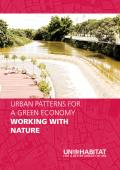
Green industrial policy (GIP) is the pursuit by governments of national economic excellence in key green economy sectors, with a view to creating globally competitive domestic firms. It differs in only a few respects from traditional industrial policy, most significantly with respect to the potential global environmental benefit that comes from private sector innovation and competition in these sectors.
GIP is increasingly used by governments in the developed and developing countries, a trend that is likely to be reinforced in coming years by the desire to capture the environmental and economic benefits of green economy sectors. However, as with traditional industrial policy, it is easy to implement policies that undermine rather than support the intended goals.
Part of a series of four entitled Urban Patterns for a Green Economy, this guide explores the compact city and its benefits within the developed and developing world's contexts. The guide illustrates how the compact city concept and planned (versus unplanned) urban extension can support sustainable urban patterns that benefit the functioning of developed as well as developing world cities. Properly managed, compaction can positively enhance the life of the city dweller and support related strategies aimed at promoting a green economy and sustainable urban settlements.
The guide contains case studies from Vauban (Freiburg), Medellín, Bangkok, Cairo, Ouagadougou, Rio de Janeiro, Isfahan, and Newcastle (Australia).

Part of a series of four entitled Urban Patterns for a Green Economy, this guide (Working with Nature) focuses on the effect of unplanned, rapid growth of cities on the functioning of a city-region's natural systems. It outlines how guided development can maximise the ability of ecosystems to support sustainable human and natural processes. It offers a perspective on how to work with nature and the ecological processes in regions, and looks at the need to work across scales; to understand regional systems; and develop principles and measures that can be applied at the regional, city and local scales.
This guide includes case studies from Dar es Salaam City, New York City, Seoul, Hangzhou, Berlin, Cape Town, Nueva Vizcaya, and Zagreb.
This publication, by UNEP, aims to identify the challenges faced in attempting to decouple human well‐being from resource consumption and exists as the first report amongst many investigations into decoupling which will be undertaken by the International Resource Panel and UNEP over the next few years. The report offers facts and statistics of natural resource flows and trade globally and notes that consumption of natural resources is still rapidly rising. A series of country wide case studies (Germany, South Africa, China and Japan) are presented that examine the decoupling potential of the countries in question. The report observes that developed countries appear to show stabilisation of resource and energy consumption however these economies appear to have exported the more energy and resource intensive elements elsewhere. There appears to be some success of relative decoupling (where resource intensity per unit growth falls) in developing countries but resource consumption in these economies is ‘steeply on the rise’.
